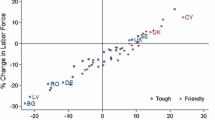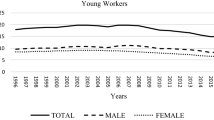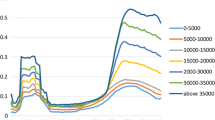Abstract
Countries that aim at capturing a Demographic Dividend should target improving their dependency ratio. To reach this objective, they need to develop policies at different levels. The first one is demographic: they need to control the mortality and fertility rates so that the ratio between the “pre- and post- working age” population and the “working age” population improves. The second one is employment: they need to increase the labor market’s absorptive capacity so that the ratio between the “unemployed” population and the “employed” population improves. The third one is socioeconomic: they need to increase the average income (starting with the minimum wage) so that the ratio between the individuals “consuming more than they earn” and the individuals “earning more than they consume” improves. Finally, the fourth level is macroeconomic: fiscal and monetary policies should ensure that the financial resources liberated by a decrease in the dependency burden are productively invested to boost economic growth.
Access this chapter
Tax calculation will be finalised at checkout
Purchases are for personal use only
Similar content being viewed by others
Notes
- 1.
The concept of dependency burden is in many respects similar to the global burden of disease as dependency is considered as a global cost that should be borne by the whole economy of a country, and especially by those who are contributing to the GDP of this economy. This global cost includes all direct (at household level) and indirect (at meso and macro levels) expenditures that are needed to bring an educated and healthy youth to working age as well as ensuring a decent retirement to the elderly.
- 2.
The Sahel Women’s Empowerment and Demographic Dividend (SWEDD) project countries are Benin, Burkina Faso, Chad, Cote d’Ivoire, Mali, Mauritania and Niger.
References
Bloom, D., & Canning, D. (2001). Cumulative causality, economic growth, and the demographic transition. In N. Birdsall, A. C. Kelley, & S. W. Sinding (Eds.), Population matters: Demographic change, economic growth, and poverty in the developing world (pp. 165–197). Oxford University Press.
Bloom, D., Canning, D., & Sevilla, J. (2003). The demographic dividend: A new perspective on the economic consequences of population change. Rand Corporation.
Bongaarts, J. (2009). Human population growth and the demographic transition. The Population Council.
Bongaarts, J. (2017). Africa’s unique fertility transition. In J. B. Casterline & J. Bongaarts (Eds.), Fertility transition in sub-Saharan Africa. Population and development review, 43(Suppl), 39–58.
Cunningham, W. (2007). Minimum wages and social policies. Lessons from developing countries. World Bank Group.
Cutler, J., Poterba, M., et al. (1990). An aging society: Opportunity or challenge? MIT, Harvard University.
Drummond, P., Thakoor, V., & Yu, S. (2013). Africa rising: Harnessing the demographic dividend. International Monetary Fund.
Eberstadt, N. (2017). Manpower, education, skills and jobs in sub-Saharan Africa: Past trends and future outlook. In H. Groth & J. F. May (Eds.), Africa’s population: In search of a demographic dividend (pp. 225–250). Springer.
Groth, H., & May, J. F. (Eds.). (2017). Africa’s population: In search of a demographic dividend. Springer.
Groth, H., May, J. F., & Turbat, V. (2019). Policies needed to capture a demographic dividend in sub-Saharan Africa. Canadian Studies in Population, 46(1), 61–72.
Guengant, J. P. (2017). Africa’s population: History, current status, and projections. In H. Groth & J. F. May (Eds.), Africa’s population: In search of a demographic dividend (pp. 11–31). Springer.
ILO. (2013). Employment and social protection in the new demographic context. Report IV, International Labour Conference, 102nd Session. International Labour Organization.
ILO. (2016). Global youth unemployment is on the rise again. In World employment and social outlook 2016: Trends for youth. International Labour Organization.
Kipesha, E., & Msigwa, R. E. (2013). Determinants of youth unemployment in developing countries: Evidences from Tanzania. Journal of Economic and Sustainable Development, 4(14), 67–76.
Lee, R. D., & Mason, A. (2006). What is the demographic dividend? Finance & Development, 43(3), 16–17.
Lee, M., Christianson, H., & Bietsch, K. (2016). Global employment and the sustainable development goals. Population Bulletin, 71(2).
Lesthaeghe, R. (2010). The unfolding story of the second demographic transition. Population and Development Review, 36(2), 211–251.
May, J. F. (2012). World population policies: Their origin, evolution, and impact. Springer.
May, J. F. (2017). The politics of family planning policies and programs in sub-Saharan Africa. Population and Development Review, 43(Suppl), 308–329.
May, J. F., & Guengant, J. P. (2020). Demography and economic emergence of sub-Saharan Africa (Series Pocket Book Academy, Vol. 134-EN). Académie royale de Belgique.
May, J. F., & Rotenberg, S. (2020). A call for better integrated policies to accelerate the fertility decline in sub-Saharan Africa. Studies in Family Planning, 52(2), 193–204.
May, J. F., & Turbat, V. (2017). The demographic dividend in sub-Saharan Africa: Two issues that need more attention. Journal of Demographic Economics, 83(1), 77–84.
Parant, A., & Hommel, T. (2019). La fenêtre démographique en Afrique de l’Ouest : une ouverture différée. Futuribles International, 220, 1–18.
Patierno, K., Gaith, S., & Madsen, E. L. (2019). Which policies promote a demographic dividend? An evidence review. Population Reference Bureau.
Pettinger, T. (2019). Policies for economic development. Economics Help; see https://www.economicshelp.org/blog/4998/development/policies-for-economic-development/. Accessed 27 Mar 2021.
Population Reference Bureau. (2020). 2020 world population data sheet. Population Reference Bureau.
Rostow, W. W. (1960). The stages of economic growth: A non-communist manifesto. Cambridge University Press.
Terrell, K., & Almeida, R. K. (2008). Minimum wages in developing countries: Helping or hurting workers? (Employment policy primer, No. 10). World Bank Group.
Turbat, V. (2017). The demographic dividend: A potential surplus generated by a demographic transition. In H. Groth & J. F. May (Eds.), Africa’s population: In search of a demographic dividend (pp. 181–195). Springer.
Turra, C., & Queiroz, B. (2005). Before it’s too late: Demographic transition, labour supply, and social security problems in Brazil. United Nations, Department of Economic and Social Affairs, Population Division.
United Nations. (2013). National transfer accounts manual: Measuring and analyzing the generational economy. United Nations, Department of Economic and Social Affairs, Population Division.
United Nations. (2019). World population prospects. The 2019 revision. United Nations, Department of Economic and Social Affairs, Population Division.
World Bank. (2007). Capturing the demographic bonus in Ethiopia: Gender, development, and demographic actions. World Bank Group.
World Bank. (2014). Sahel women empowerment and demographic dividend project phase 1. World Bank Group.
World Bank. (2015). Africa’s demographic transition: Dividend or disaster? (Africa development forum). World Bank Group.
World Bank/International Monetary Fund. (2016). Global monitoring report 2015/2016: Development goals in an era of demographic change. World Bank Group.
Author information
Authors and Affiliations
Corresponding author
Editor information
Editors and Affiliations
Rights and permissions
Copyright information
© 2022 Springer Nature Switzerland AG
About this chapter
Cite this chapter
Turbat, V. (2022). Policies Needed to Capture Demographic Dividends. In: May, J.F., Goldstone, J.A. (eds) International Handbook of Population Policies. International Handbooks of Population, vol 11. Springer, Cham. https://doi.org/10.1007/978-3-031-02040-7_19
Download citation
DOI: https://doi.org/10.1007/978-3-031-02040-7_19
Published:
Publisher Name: Springer, Cham
Print ISBN: 978-3-031-01998-2
Online ISBN: 978-3-031-02040-7
eBook Packages: Social SciencesSocial Sciences (R0)




